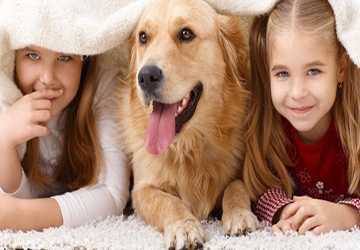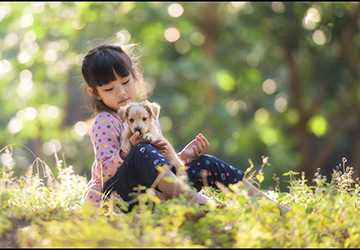Pets are essential in our lives, providing companionship, love, and joy. Owning a pet is a transformative experience for children, teaching them necessary life skills and fostering deep emotional connections.
In this article, you'll learn how to encourage a bond between your child and your pet. Whether you have a furry friend at home or consider adding one to your family, these insights will help build a harmonious and loving relationship between your child and their four-legged companion.
Choose the right pet.
The first step in developing a solid bond between your child and your pet is choosing the right type of pet. The choice should be based on the child's age, personality, and lifestyle. For example, an energetic dog may be suitable for an active household, while a low-maintenance pet like a hamster may be better suited for younger children. It's essential to consider your family's living situation and any allergies or phobias family members may have.

Teach responsibility
One of the most valuable lessons a child learns from owning a pet is responsibility. Assign age-appropriate tasks related to pet care, such as B. Feeding, grooming, and cleaning. By caring for a pet's basic needs, children develop a sense of responsibility and learn the importance of routine and consistency.
Supervision and education
Supervision is essential, especially if the pet is a new family member or the children are very young. Teach your children how to interact with pets safely. Explain the importance of treating animals gently and respecting their boundaries. This keeps children and pets safe and helps build trust between them.
Encourage play
Playtime is an excellent way for children and pets to bond. Please encourage your children to retrieve, hide, pet, and cuddle their furry friends. These interactions create positive bonds and strengthen the emotional bond between child and pet.
Teach empathy and compassion.
Children learn essential life lessons about empathy and compassion by caring for pets. Use pet care time to discuss your pet's feelings and needs. Make it clear to your children that animals have emotions, too, and their welfare should be prioritized. This understanding can extend beyond pets and influence how your child interacts with others.
Create a haven
Set up a safe place in your home where your pets and children can live together peacefully. This area should be comfortable for both parties and provide comfortable bedding, toys for the pet, and a place for the children to read or play. To maintain a positive relationship, your pet must have a sanctuary where they can rest when they need a break from interaction.
Encourage contact activities
Bonding activities are a great way to strengthen the bond between your child and their pet. Activities you can try include:
Read Aloud Time: Reading pet books or animal stories to your children and their pets can be a fun and educational experience that strengthens their bond.
Training: If you have a dog, have your child attend induction training. This helps the pet learn commands and enhances the child's sense of responsibility and control.
Arts and Crafts: Encourage your children to create art projects around their pets, such as B. Painting, creating a collage, or designing personal pet accessories.
Outdoor Adventures: Plan a family outing with your pet, such as a hike, picnic, or visit a pet-friendly park. These excursions provide opportunities to share experiences and lasting memories.

Lead by example
Children learn by watching their parents. So, set a positive example in your relationship with your family pet. Show kindness, patience, and affection towards animals. Your child may imitate these behaviors. When children see their parents treating animals with love and respect, they are likelier to do so.
Open communication
Encourage open communication between your children and pets. Although animals may not understand words like humans, they are sensitive to tone and body language. Teach your child to speak to your pet gently and soothingly, using a calm tone. This promotes a sense of security and trust between them.
Celebrate milestones
Celebrate relationship milestones as your children and their pets grow together. This could be the pet's birthday, adoption day, or even their first meeting anniversary. Recognizing these memorable moments can strengthen bonds and make pets feel like an integral part of the family.
Respect individual personality
Like people, pets have unique personalities. It is essential to recognize and respect these differences. Some pets may be outgoing and playful, while others may be more reserved and independent. Teach your children that it's okay for their pets to have their preferences and boundaries, and encourage them to adjust their interactions accordingly.
Meet challenges gracefully
No relationship is without challenges, and the relationship between children and pets is no exception. Sometimes, pets misbehave, or children make mistakes in their care. Use these moments as opportunities to learn and grow, not as punishment. Please help your children understand the consequences of their actions and help them make better decisions.
Diploma
Developing a strong bond between a child and a pet is a rewarding experience for both children and animals. It teaches children valuable life skills such as responsibility, empathy, and compassion while also being a loyal and loving companion.
By choosing the right pet, teaching responsibility, monitoring interactions, and encouraging positive bonding activities, you can build lasting, deep bonds that will benefit your children and their furry friends for years. Remember, the relationship between a child and a pet is valuable and can shape his character and bring him joy throughout his life.
